House prices in Slovakia are recovering
 For four quarters, Slovakia´s housing market has seen small annual price gains. Its housing market is beginning to recover, stimulated by a strengthening economy. It is early days, but the pattern is now a familiar one in Eastern Europe, as each country recovers from the recession and takes advantage of its lower labour costs.
For four quarters, Slovakia´s housing market has seen small annual price gains. Its housing market is beginning to recover, stimulated by a strengthening economy. It is early days, but the pattern is now a familiar one in Eastern Europe, as each country recovers from the recession and takes advantage of its lower labour costs.
Average residential property prices in Slovakia rose by 1.15% to €1,229 (US$ 1,318) per square metre (sq. m.) during the year to Q3 2015. the country´s highest y-o-y increase since the housing market depression started in Q1 2009, based on the figures from the National Bank of Slovakia (NBS). When adjusted for inflation, property prices rose by 1.46% over the same period. On a quarterly basis, property prices rose by 0.66% in Q3 2015 (0.96% in real terms).
The housing boom in Slovakia lasted from 2006 to Q2 2008, with house price rises ranging from 14% to 35% per annum. The surge stopped in late 2008, and since then prices have fallen continuously, the latest year excepted. Slovakia’s house prices are now 20.7% below their peak in Q2 2008 (-29.2% in real terms).
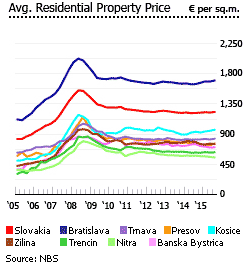
Bratislava region, which has the country´s highest house prices, spearheaded the price rises with a 3.23% price rise to price rise to €1,695 (US$ 1,818) per sq. m. during the year to Q3 2015 (3.54% in real terms). Other regions with y-o-y price increases in Q3 2015 include: Kosice (3.10%), Trnava (1.09%) and Trencin (0.64%).
Regions with residential property price declines:
- Banska Bystrica experienced the biggest plunge of about 6.37% (-6.08% in real terms) to €706 (US$ 757) per sq. m. during the year to Q3 2015.
- House prices in Nitra fell by 4.47% (-4.18% in real terms) y-o-y to €556 (US$ 596) per sq. m.
- In Zilina, prices dropped by 3.83% (-3.54% in real terms) to €753 (US$ 807) per sq. m. during the same period.
- Presov experienced a small nominal house price decline of 0.13% to €763 (US$ 818) per sq. m., but actually rose by 0.17% when adjusted for inflation, during the year to Q3 2015.
Flats registered house price gains nationally, surging by 5.59% (5.91% in real terms) to €1,361 (US$ 1,459) per sq. m. during the year to Q3 2015. Houses fell in value by 1.55% (-1.25% in real terms) to €1,079 (US$ 1,157) per sq. m. Villa prices also fell by 1.88% (-1.58% in real terms) to €1,776 (US$ 1,904) per sq. m.
Historic low mortgage rates
Mortgage loan growth has been 12.6% annually from 2009 to 2014, with volumes rising from €9.5 billion (US$ 10.15 billion) in 2009 to €17.4 billion (US$ 18.62 billion) in 2014. During the boom years, the volume of housing loans to households rose 30% annually from 2005 to 2008.
Average housing loan rates in September 2015:
- Average floating rate loan interest rate, or loans with interest rate fixation (IRF) of up to 1 year: 2.99%
- IRF over 1 to 5 years: 2.38%
- IRF over 5 years: 4.78%
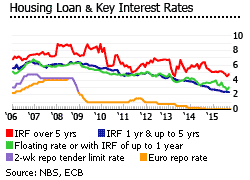
The continuous decline of interest rates on housing loans in Slovakia is due to the European Central Bank (ECB) cutting its key rate seven times since November 2011 to a historic low of 0.05% in September 2014. Yet these cuts have had less effect than might be expected on Slovakia´s housing market, as banks have become very cautious. Slovakia still has one of the lowest mortgage-debt-to-GDP ratios in the EU, at 23.1% of GDP in 2014, less than half of the EU 28´s ratio of 49.6%.
What will happen to interest rates now? ECB President Mario Draghi recently signaled that the ECB might expand quantitative easing and further reduce its deposit rate, which now stands at -0.2%, in its attempt to raise euro inflation to its target just below 2%. Euro area annual inflation was 0.1% y-o-y, up from -0.1% the previous month, according to Eurostat. (Slovakia had an annual inflation rate of -0.6% in October 2015). The ECB´s next meeting is on December 3, 2015.
Rental market is very limited
Owner-occupancy in Slovakia has risen sharply from 49.7% in 1990 to 90.3% in 2014, making Slovakia the country with the third highest homeownership rate in the EU, way past the EU average of 70.1% in 2014. Tenants consisted of only around 9.7% of Slovakia´s population in 2014, according to Eurostat.
But only 0.1% of Slovakia’s housing stock is let out by private landlords, mainly in Bratislava.
The growth of owner-occupation is partly due to a contractual savings system (Bauspar) that makes it easy for Slovaks to obtain housing loans. This Bauspar system allows borrowers to take loans at lower interest rates, with the government paying an interest premium on the amount saved.
In 2005, the government decreed the abolition of rent control, effective July 1, 2007. However, the decree was never implemented. Rent deregulation has been postponed repeatedly, as Parliament refuses to deal with this highly sensitive issue.
Yields are up; rents are still low
According to the Global Property Guide research in July 2014, in Stare Mesto, Bratislava´s city centre:
- Gross rental yields on 60 sq. m. and 90 sq. m. apartments were 5.48% and 5.73%, respectively.
- Larger units of around 200 sq. m. had slightly lower yields of around 5.32%.
- The average yield in Stare Mesto improved to around 5.53% in July 2014, from the previous year´s average of 5%.
In the Bratislava´s less upscale districts of Ruzinov and Nove Mesto (Bratislava II and III), gross rental yields were between 5.23% to 6.36%.
The average rent in Stare Mesto fell by 5% during the year to €1,106 per month in July 2014. Rents in Bratislava II and III also fell as compared to the previous year, with its average rent declining by 5.6% to € 620 per month from an average of € 657 per month in July 2013.
The rent price decline in the recent years is also attributed to the rise of housing supply around Bratislava. In 2014, about 2,500 new apartments were sold in Bratislava, as reported by stavebneforum.sk, an increase from 2,258 apartments sold the previous year.
AVERAGE RESIDENTIAL PROPERTY PRICES |
||||
| PER SQ. M (Q3 2015) | Q-O-Q CHANGE | Y-O-Y CHANGE | HOUSE PRICE BOOM (2005 2008) | |
| SLOVAKIA | 1,229 | 0.66 | 1.15 | 76.52 |
| REGIONS | ||||
| Bratislava | 1,695 | 0.89 | 3.23 | 71.78 |
| Tranava | 832 | 1.22 | 1.09 | 55.25 |
| Nitra | 556 | -1.42 | -4.47 | 103.84 |
| Trencin | 632 | 0.80 | 0.64 | 140.58 |
| Zilina | 753 | -1.05 | -3.83 | 109.07 |
| Banska Bystrica | 706 | 0.43 | -6.37 | 101.66 |
| Kosice | 965 | 1.47 | 3.10 | 117.82 |
| Presov | 763 | 3.39 | -0.13 | 77.53 |
| PROPERTY TYPE | ||||
| Total flats | 1,361 | 1.34 | 5.59 | 87.16 |
| 1-i | 1,483 | 2.13 | 5.85 | 104.07 |
| 2-i | 1,411 | 1.22 | 5.38 | 91.11 |
| 3-i | 1,299 | 1.17 | 5.78 | 77.29 |
| 4-i | 1,308 | 1.08 | 6.00 | 80.84 |
| 5-i+ | 1,456 | 3.34 | 2.54 | 56.43 |
| total houses | 1,079 | 0.09 | -1.55 | 38.80 |
| houses | 1,063 | 0.19 | -1.48 | 39.40 |
| villas | 1,776 | -3.16 | -1.88 | 25.30 |
| Source: National Bank of Slovakia | ||||
End of the flat tax
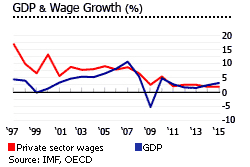
One of the most famous characteristics of the Slovak economy was previously its ‘flat tax’ of 19% on income, consumption, and corporate profits, operative since 2004. However, Slovakia’s parliament scrapped the flat tax from January 1, 2013, raising income tax for corporations to 23% and for individuals earning more than €3,300 (US$ 4,498) per month to 25%.
Higher economic expansion in 2015-16
Slovakia registered 3.6% GDP growth during the year to Q3 2015, its fastest pace of economic expansion in almost five years. Industrial production growth, as well as continuous labour market gains, were the main drivers of Slovakia´s growth.
It was the fastest growth recorded among euro zone members during the quarter, followed by Spain (0.8%), Cyprus (0.5%), and Lithuania (0.5%).
The IMF and the National Bank of Slovakia (NBS) predict that the Slovakian economy will expand by 3.2% in 2015. The NBS projects growth of 3.4% in 2016.
Slovakia is one of Eastern Europe’s most successful transition countries. Born in 1993 after seceding amicably from the Czech Republic (the two countries were formerly known as Czechoslovakia), it has a stable polity and liberal market economy. Slovakia benefited from eight years’ reform under the centre-right coalition led by Mikulas Dzurinda (1998-2004) whose reforms won praise from international organizations, and who oversaw EU and Nato entry.
The economy’s rapid growth facilitated the country’s membership of the Organization for Economic Cooperation and Development (OECD) and the European Union (EU) in 2004. In December 2007 Slovakia became a full member of the Schengen Zone, allowing passport-free travel in the 24-member European nations.
Real GDP growth reached an impressive 10.7% in 2007, following 8.3% for 2006, 6.5% for 2005, and 5.2% for 2004. Kia, Volkswagen, and Peugeot Citroen all have built large car plants in Slovakia.
Since then, Slovakia has had two terms under the socialist and populist leader Robert Fico, of the Smer party (prime minister 2006-2010, and 2012 to present).
Fico’s stewardship has been marked by tension with Hungary, populism towards Slovakia’s Roma population, and weaker economic growth
In 2008 there was 5.4% growth, and then a collapse with the crisis and a 5.3% GDP contraction in 2009. Slovakia’s economy recovered with GDP growth of 4.8% in 2010, but this was followed by 3 weak years, with 2.7% GDP growth in 2011, 1.6% in 2012 and 1.4% in 2013. In 2014, the economy bounced back somehow, recording a 2.4% expansion.
Unemployment was around 11.38% in September 2015, according to the Central Office of Labour, Social Affairs and Family (ÚPSVaR), 1.06% less than last year.
“We are still at six-year low when it comes to the unemployment development, while regarding the number of new jobs we are at a seven-year high,” said Labour Minister Ján Richter, as quoted by the SITA newswire.
Slovakia´s improving economy should pave way for new jobs, and lower unemployment in the next few months, says Ľubomír Koršňák, analyst for UniCredit Bank Czech Republic and Slovakia.
Resistance to accepting refugees
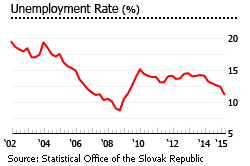
In October 2015, Slovak Prime Minister Robert Fico stated that the Slovakian government will file a lawsuit against the European Union´s (EU) mandatory immigration quotas on December 18, 2015 at the European Court of Justice (ECJ). Fico even warned that he is ready to propose "a discharge of his country from the European Union" if the EU insisted Slovakia in taking in refugees from the Middle East.
Fico clarified that the lawsuit was due to the way the relocation of around 120,000 migrants (that are currently staying in Italy and Greece) was decided upon, and not against the migrants themselves.
Earlier this year, a lot of refugees and migrants coming from the Middle Eastern and African countries, flocked to Europe and seeking asylum after being displaced due to ongoing conflicts in their home countries. According to Eurostat, about 626,715 asylum applications were received by EU member countries in 2014, and a whooping 816,500 applications were added during the first 9 months of 2015.
Based on the decision of EU´s interior ministers on September 22, Slovakia is supposed to accept 802 refugees (612 from Greece and 190 from Italy). But Slovakia has been ignoring the quota and has not yet installed liaison officers who will choose among refugees in Greece.
At the end of October, Slovakia grudgingly stated that it will accept a maximum of 200 refugees.
A new face in the Presidency
Slovakia’s new President Andrej Kiska was elected in March 2014, and assumed office on June 15, 2014. A political newbie, Kiska defeated current Prime Minister Robert Fico (Smer) and replaced Smer ally Ivan Gašparovič.
He is an independent, with a background as a philanthropist and entrepreneur. He is also the first Slovak president with no communist past. Kiska won decisively in the second round of the 2014 elections, receiving nearly 60% of the vote.
However, the presidency is largely a ceremonial office, though Kiska hopes to create a more healthy balance of power between president and the Cabinet, as well as strengthening the Judiciary’s independence.